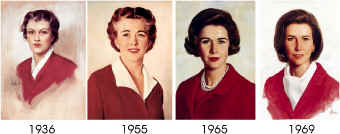|
Betty Crocker by Cheryl M. Keyser
This was Betty Crocker. However, she was not a real person, but rather a marketing inspiration of General Mills, a flour milling company, now in its 150th year in business. General Mills merged with another milling company, Washburn-Crosby which came up with Betty Crocker. The name "Betty" was chosen as it was considered a friendly name that homemakers could relate to. Crocker was the last name of one of the directors of Washburn-Crosby. Along with the name "Betty Crocker" General Mills also came up with the red spoon logo still in use today. In 1921, Washburn-Crosby created a contest published in the then highly-popular and widely-circulated Saturday Evening Post. With that Betty was born. At one time, she was so popular a figure that she was receiving 7,000 letters a day. Over the years, the Betty Crocker image has been modified, but basically she is the same comfortable-looking woman as when she was first introduced to consumers, her face attracting women to buy her products but also for another ingenious marketing tool - coupons. Starting in 1929, the coupons were enclosed in bags of flour. (This was also a period when women were doing more baking from scratch than is common now.)
This form of advertising is known as promotional premiums. They are the items used by a variety of companies to provide an incentive for consumers to buy their products. They can be anything from a paper coupon to the toys in a Cracker Jack box. The advantage of this was that the consumer was rewarded for buying the product by receiving something of value in return. To redeem the premium, a proof of purchase was required, whether a paper coupon or something that had to be cut from the product box, usually a box top. (This is such an effective way for a company to reach out to consumers, that in today's Internet world, modified in form, such premiums are still in vogue.)
By 1937, the coupons began to be printed on the outside of the Betty Crocker item. Point values were assigned to the coupons and could be redeemed through the Betty Crocker Catalog, which was broadened to include cookbooks, kitchenware, and decorative home items. The buyer could receive discounts of anywhere from 25% to 75%. In 1992, the premium program was renamed the "Betty Crocker Catalog Points." At the end of 2006, General Mills discontinued the Catalog after 75 years. The promotion has changed and now used box tops can be clipped from the box and used for the "Box Tops for Education," program started in 1996, which is used to help schools pay for education supplies for students. (And, of course, actual box tops are no longer needed as everything is digitally available now.) There is also another element to this tale, one which ties Betty Crocker to early American history. The company that produced the stainless steel flatware for the Crocker promotion was Oneida, a utopian community in upstate New York. The members produced a variety of products from animal traps to silk items - and silverware. It had a good reputation for the quality of its goods - and is still being sold today. The Oneidas were of the original five (later six) native American nations which formed the Iroquis Confederacy. In 2006, the Betty Crocker Catalog was "retired." Crocker's image is no longer on boxes, although the red spoon is still. But, there is a small note to consumers on the side of the packages, signed by Betty Crocker. All of the products carrying her name are still going strong, as are her cookbooks. It is a true triumph for the advertising business, that this iconic figure still speaks to new generations. Finally, this famous lady has her own website, http://www.BettyCrocker.com, and information on the education program can be found at http://www.generalmills.com. |


 The
original coupons could be redeemed for a variety of items. One of the
most popular was a piece of Oneida flatware - a single spoon, fork, or
knife. Oneida was then a well-known brand, and for a housewife,
acquiring a set of quality flatware via a coupon, even if accumulated
over time, was a great attraction. Later on, the coupon could be used
to redeem an entire set of Oneida flatware, in a pattern known as
"Friendship."
The
original coupons could be redeemed for a variety of items. One of the
most popular was a piece of Oneida flatware - a single spoon, fork, or
knife. Oneida was then a well-known brand, and for a housewife,
acquiring a set of quality flatware via a coupon, even if accumulated
over time, was a great attraction. Later on, the coupon could be used
to redeem an entire set of Oneida flatware, in a pattern known as
"Friendship."